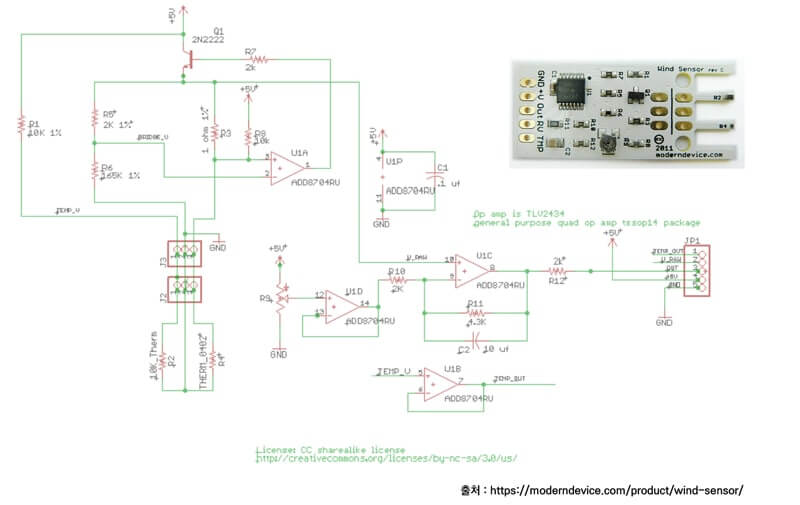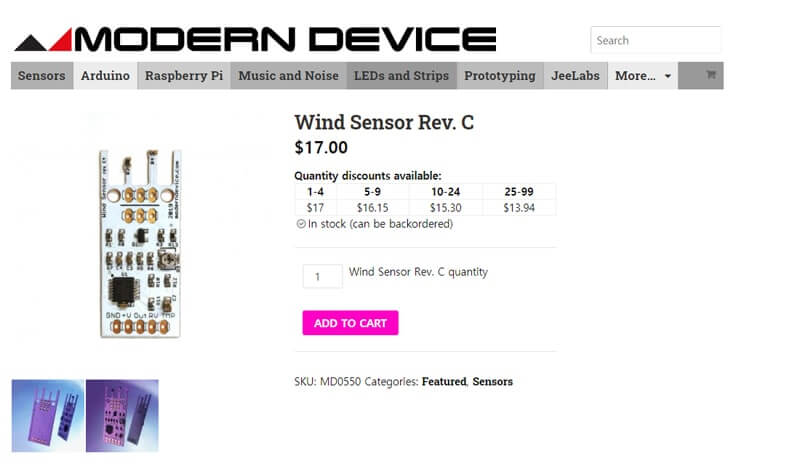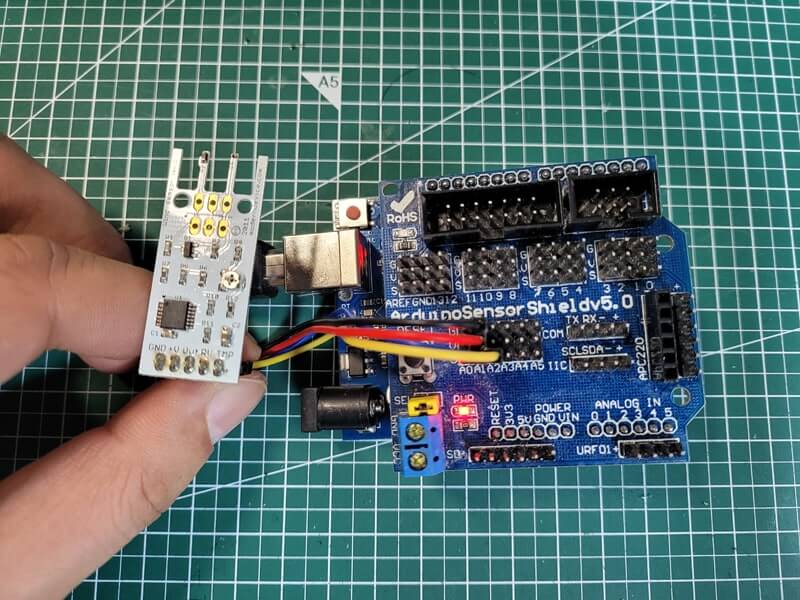This chapter explains how to use the MD0550 sensor. You will learn its features, operating principles, specifications, connection pin arrangement, output values, and connect Arduino and the sensor together to measure the air around you easily using the library.
Contents
MD0550 Airflow Sensor

Airflow is the flow of air generated by the difference between air pressure and temperature, and the flow of air is generated by artificial winds. Airflow units are either m/s (meter per second) or mph (miles per hour).
Airflow in the room is generated by ventilation (natural ventilation, mechanical ventilation) or ventilation. Ventilation is helpful for creating a more comfortable indoor air quality. If it is hot or cold in the summer or winter, we turn on an air conditioner and fan, all of these devices generate indoor airflow. In addition, air purifiers, air circulators, and fans also generate indoor airflow.
Ventilation effect: fresh air from the outside enters the room through a window or door and polluted air escapes upwards, allowing clean indoor air to be maintained.
However, these days, like passive houses, houses are built to increase indoor airtight rate of heating and cooling to increase energy efficiency. Due to poor ventilation, air flow is not smooth, and air pollutants in the room become stagnant.
The house we live in also needs to breathe. Just as a person is healthy when blood circulation is normal, indoor air flow must be circulated well to create a pleasant environment for people to live in. Airflow affects the movement of indoor air pollutants and temperature. The wind promotes heat dissipation from the human body. Every 1 m/s of wind speed feels the same as a temperature drop of 1℃.
Depending on the airflow, air pollutants generated indoors may be stagnant or circulated, or may be introduced from the outside.
Effects on the human body
Just as people need good blood circulation to be healthy, indoor spaces must also be well circulated to become a comfortable indoor space. Airflow affects the warmth comfort felt by humans and the movement of indoor air pollutants.
Thermal comfort:
Indoor air velocity also affects the thermal comfort of people in the room. The higher the air velocity, the greater the heat exchange between the person in the room and the surrounding air. ASHARA (American Society for Heating, Refrigerating and Air Conditioning) defines warmth comfort, which is a human sense of the temperature of the environment, as a state of mind that is satisfied with the environment in a thermally neutral state that is neither hot nor cold. Factors influencing human comfort in a warm environment include physical factors such as temperature, humidity, air current, radiation temperature, and environmental factors such as noise, lighting, and weather, as well as personal factors such as gender, age, constitution, and psychological factors are also considered.
In winter, cold, strong drafts can enter the interior of houses. In order to prevent drafts, weather strips and bubble wrap are attached between gaps to prevent wind blowing through the gaps. Insulation reinforcement work is sometimes done to prevent cold air from penetrating into the ceiling or walls. Cold drafts affect the warmth comfort of the room. In summer, hot air from outside comes in through the windows due to the difference in temperature between the outside and inside, and it is not cool even when the air conditioner is turned on, which affects the thermal comfort.
Therefore, even if you are indoors, if the indoor airflow is not smooth, it will be hot in summer and cold in winter.
| Indoor air pollution: Depending on the airflow, air pollutants generated indoors may be stagnated or circulated. In addition, air pollutants introduced from the outside may be introduced into the interior and affect the human body. For this reason, studies to predict the diffusion characteristics of indoor pollutants in spaces where indoor pollutant concentration is expected to change due to air currents have been published. Representatively, studies are being conducted to measure the airflow in the room through numerical analysis of the equation of fluid motion using CFD (Computational Fluid Dynamics) method. Indoor air pollutants occur in various ways depending on the characteristics of indoor buildings, seasons, regions, indoor occupants, ventilation types, and lifestyles. In addition, external air pollutants can increase indoor air pollution. In large cities, polluted air such as automobile exhaust gas can enter into indoor spaces. Indoor air has a very close relationship with the atmosphere. Heated gas and dust from construction sites flowing into rooms can also pollute the indoor air. Yellow dust can also cause damage such as respiratory disease and eye disease due to the increase in dust. |
Winds of 0.15 m/s or less without cold draft are defined as still air by the American Society for Air-Conditioning (ASHRAE).
| The cold draft is when heat is continuously produced by human metabolism, which consumes surrounding heat. The feeling of being cold is when the amount of calories consumed is greater than the amount of calories produced. Cold draft phenomenon occurs when it is cold around people, when the air current is high, when humidity is low, when temperature is low due to high walls and glass surfaces, when it is cold because of insufficient insulation, and when there is a lot of wind coming through the window in winter. For example, if you are in a cold room, your feet will get colder, which is also a cold draft effect. |
MD0550 Sensor?
Modern Device's Wind Sensor Rev. C MD550 sensor is a low-cost wind speed sensor with analog output designed for use in electronic projects. Although it is a wind speed sensor, it can be used as a sensor for measuring indoor human breathing or as a monitoring sensor for HVAC (heating, ventilation, & air conditioning).

[MD0550 sensor operating principle ]
The MD0550 sensor has a total of 5 PINs and measures wind speed using RV. There are 3 signal pins and a total of 5 pins including power and ground. The latest version of the sensor with a more accurate op amp operates well between 4V-5V, but not at higher voltages.
The sensor measures wind speed by keeping the heated element at a constant temperature as the wind blows on the heated element. Wind speed is proportional to the heat (i.e. power) applied to the sensor.

• GND: connected to Arduino ground.
• +V: for best results, use 5V voltage for +V power, but 5-10V can also be used.
• OUT: Output voltage. After multiplying the voltage of RV by about 3, it is shifted by the potentiometer setting. This output voltage will be saturated (touch GND or +V) if the ambient temperature fluctuates significantly due to temperature when calibrating the sensor. The sensitivity of this output can be changed by replacing R11. The higher the sensitivity, the more easily the sensor saturates as the ambient temperature changes.
• RV: This is the original loop voltage and is the output to be used for the calibrated output. Ground or +V is not reached. Even at room temperature, it does not drop below ~1.8V. This voltage is not affected by the calibration potentiometer. The sensor output is logarithmic. In other words, the sensor can capture some air movement at its lowest value, but it will not reach its full power until the airflow reaches about 100 km per hour. The Arduino connection with the wind sensor is configured to use this pin as an output.
• TMP: Temperature output. It is a voltage divider consisting of a resistor and a thermistor. It reads about 2.8V at room temperature and goes down to higher and lower temperatures.
MD0550 sensor calibration
These sensors can be calibrated and used for precise measurements. The wind speed sensor contains a small trimmer resistor used to calibrate the sensor without wind.
• Simply put a glass on the sensor to block wind and adjust the trimmer resistor to the desired 0 level.
• Using a 6v power supply, provide 5V output without wind blowing
• The lower the calibration point (eg 0.2V), the higher the sensitivity at the high end. Recalibration is required to use with a higher voltage supply.
Purchasing the MD0550 sensor
As follows, the [MD0550] sensor used in the book [Arduino Sensors for Everyone] can be purchased at Ali Express, Amazon.

Software Coding
Run the example file in Steamedu123_Sensor-master > examples.
/*
@503 MD0550 Airflow sensor
*/
#include <C503_Steam_Air_MD0550_AirVelocity.h> // Internal library header file
#define RvPIN A2
#define TmpPIN A1
SteamMD0550 md0550(RvPIN, TmpPIN); // Instance, pin number
void setup() {
Serial.begin(57600); // Start serial communication at a speed of 57600bps.
md0550.begin(); // (1) Initialize the sensor.
}
void loop() {
md0550.read(); // (2) Measure the value of the sensor.
md0550.display(); // (3) Output the sensor value.
delay(1000); // Wait for 1 second.
}
MD0550 Arduino sensor operation check
When the hardware connection and software coding are completed, you can check the operation screen as follows.
------------------------------------------------------
Development environment: WINDOWS 10
Arduino IDE: 1.8.13
------------------------------------------------------
01 library copy
You can easily check the operation by using the library.
The libraries \Steamedu123_Sensor-master folder is copied to the folder below.
* This folder is created automatically after installing Arduino C:\Users\s\Documents\Arduino\libraries
02 *. ino file execution
-Connect Arduino and PC
-Run Arduino IDE
-Menu → Tools → Board: Check Arduino UNO
-Menu → Sketch → Check/Compile
03 Check compilation
Select Sketch>OK/Compile (CTRL+R) to compile.
04 Arduino Uno upload
When the compilation is completed without any problems, select Sketch>Upload (CTRL+U) to upload the compiled file.
05 Operation check
You can check the operation as follows.

Wrap-up
You can connect Arduino and [MD0550] sensor and practice the sensor easily with simple coding.
In this section, we investigated the effects of indoor airflow on the human body, the reference concentration, the measurement range of simple measuring instruments, and the sensors used in measuring instruments. We learned how to control the MD0550 sensor, and with Arduino, we measured airflow.
The sensors installed at locations far, near, or at a distance from the window, and installed at three heights vertically at the top, middle, and bottom can measure temperature and airflow, continuously monitoring the accurate temperature and airflow distribution in the room and can be used to help control indoor air. In this section, we examined the effect of indoor airflow on the human body, the measurement range of the standard concentration, and the measurement range of simple measuring instruments, and the sensors used in the measuring instruments.
Indoor air must be circulated. If the wind speed is appropriate, it is pleasant. However, if it is even slightly higher than normal, it can be unpleasant. In addition, indoor air pollutants should not be stagnant in one place and should be circulated and discharged outdoors. Adequate ventilation is required.
Airflow is created and affects us due to various factors such as temperature, humidity, atmospheric pressure, drafts, building materials, and lifestyle. For pleasant indoor environments, sensors should be installed at locations far, near, and intermediate distances from windows according to the ASHRAE standard of the American Air Conditioning System Association. Sensors can be installed at three different heights to measure temperature and airflow. It can be used to continuously monitor the exact temperature and airflow distribution in the room and to control HVAC (Heating, Ventilation, and Air Conditioning).
References
References for [MD0550 Air Flow Arduino Sensor] used in the book [Arduino Sensors for Everyone] are as follows. \
[30] Analysis of physiological quantities related to Draft according to the generation of air currents and indoor temperatures, Jang Chung-seon, Geum Jong-su, Park Jong-il, Shin Byung-hwan, Lee Jae-kwon, Kim Young-saeng, Journal of Korea Institute of Facilities Engineering, 2004
[31] Prediction of Indoor VOCs by the Heat Exchange Ventilation System, Kim Chang-nam, Kim Dong-seok, Kim Tae-yeon, Lee Yoon-gyu, Lee Seung-bok, and Apartment Space, 2005 Annual Conference of the Korea Institute of Facilities Engineering
[32] A Study on the Selection of Optimal Ventilation Method based on Indoor Airflow Analysis for Multi-use Facilities and Residential Facilities in the Operation Maintenance Stage, Park Joo-young, Sung Hyun-woo, Kim Yong-soo, 2020
[33] The Effect of Indoor Airflow Spread and Thermal Environment Improvement on Air Conditioning Applications, Lee Kyu-nam, Jung Geun-joo, and Air Circulator, A dissertation of the Korea Institute of Environmental-Friendly Facilities, 2017
[34] The Effect of Air Flow Characteristics in Residential Environments on Indoor Air Cleanliness and the Academic Presentation of the Korea Institute of Facilities Engineering, Song Woo-suk, Seo Hyung-joon, Kim Young-jae, 2014
[35] Naver Knowledge Encyclopedia, http://bit.ly/2WJ9l2R
[36] Naver Knowledge Bags and Non-Cold Air Flows, http://bit.ly/3ha4DVg
[37] ANSI/ASHRAE Addenda d, e, f, and g to ANSI/ASHRAE Standard 55-2004, Thermal Environmental Conditions for Human Occupancy
[38] Real-Time Sensor Response Characteristics of 3 Commercial Metal Oxide Sensors for Detection of BTEX and Chlorinated Aliphatic Hydrocarbon Organic Vapors, Gabriel Yurko, 2019 (https:// bit.ly/3ionIUp)
[39] Moderndevice MD0550, https://bit.ly/3oUD85m
[40] E-AV-LC-7 Datasheet, https://bit.ly/3nTlBcy
[41] Mecca Solution, wind sensor https://bit.ly/34Dun7s
[42] NETWORK Technologies Incorporated, E-AV-LC-7, https://bit.ly/38TbTCv
[43] AliExpress NF610, https://bit.ly/3o2e0Zj
[44] Modern device, "Specifications", https://bit.ly/3oUD85m
[45] Modern device, "Wind Sensor Calibration and the Wind Tunnel", https://bit.ly/3nUusKI
[46] Modern Device, Wind Sensor Calibration and the Wind Tunnel, https://bit.ly/3nUusKI
[47] Modern Device, Wind Sensor Progress, https://bit.ly/3nSegK7
Purchasing a book
[Arduino Sensors for Everyone] The book is available for purchase on Google Book and Apple Books.
In this book, you will learn how to use the PMS7003, GP2Y1010AU0F, PPD42NS, SDS011 Fine Dust Sensor, DHT22 temperature/humidity sensor, MH-Z19B carbon dioxide sensor, ZE08-CH2O formaldehyde sensor, CCS811 total volatile organic compound (TVOC) sensor , GDK101 radiation (gamma ray) sensor, MQ-131 ozone (O3) sensor, MQ-7 carbon monoxide sensor, MICS-4514 nitrogen dioxide sensor, MICS-6814 ammonia sensor, DGS-SO2 sulfur dioxide (SO2) sensor, BME280 atmospheric pressure sensor, GUVA-S12SD ultraviolet (UV) sensor, MD0550 airflow sensor, and QS-FS01 wind speed sensor.
Arduino Sensors for Everyone, 저자: Ronnie Kim - Google Play 도서
Arduino Sensors for Everyone - 저자가 Ronnie Kim인 eBook입니다. PC, Android, iOS 기기에서 Google Play 북 앱을 사용해 이 책을 읽어 보세요. 책을 다운로드하여 오프라인으로 읽거나 Arduino Sensors for Everyone을(를)
play.google.com

'Arduino Sensors > Chapter 5 Atmospheric environmental sens' 카테고리의 다른 글
| QS-FS01 Wind speed sensor [Arduino Sensors for Everyone] (0) | 2021.06.21 |
|---|---|
| GUVA-S12SD Ultraviolet Light Sensor [Arduino Sensors for Everyone] (0) | 2021.06.20 |
| BME280 Atmospheric pressure Sensor [Arduino Sensors for Everyone] (0) | 2021.06.20 |




댓글